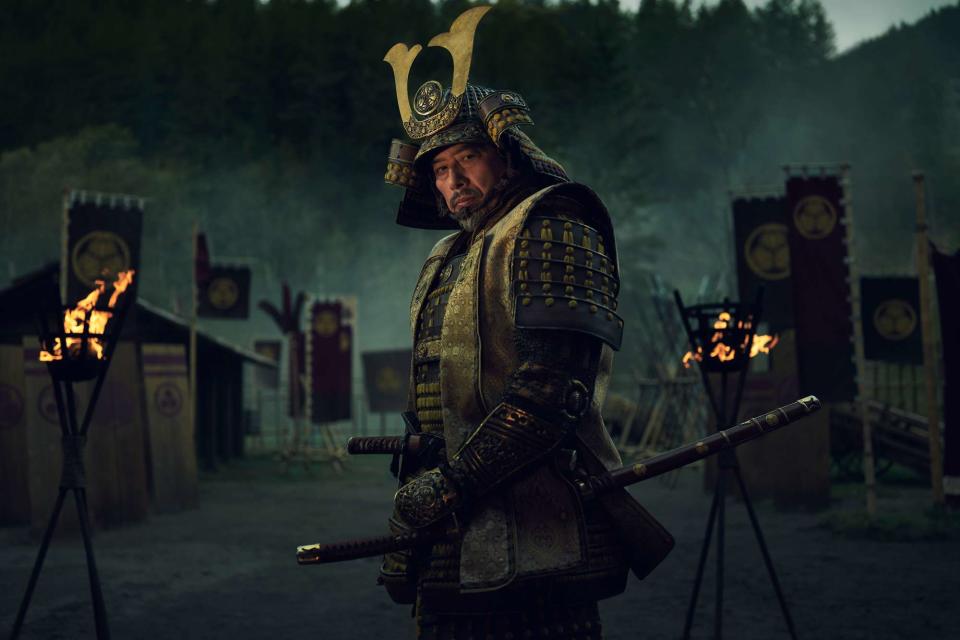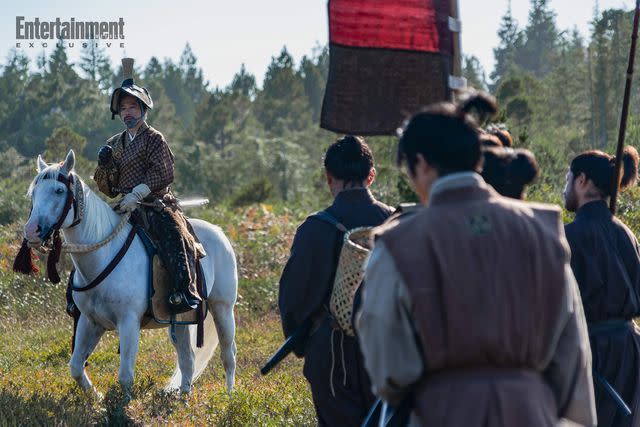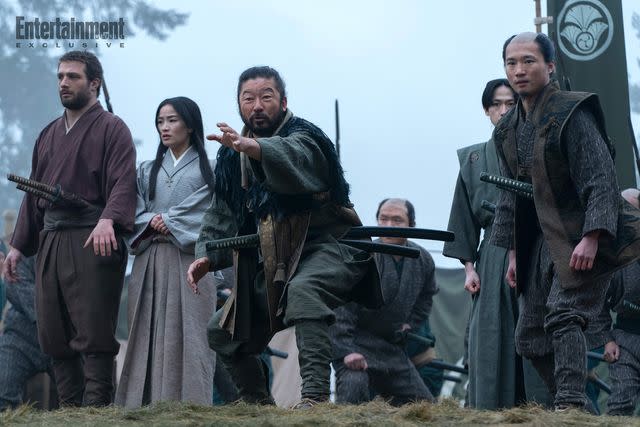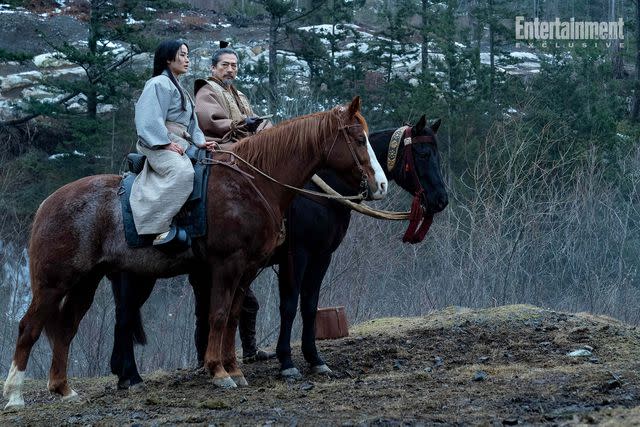Inside “Shōgun”, the “Game of Thrones”-sized samurai epic
Says co-creator Justin Marks, "If we're going to do it, let's do the kind of samurai story that Hollywood hasn't seen before."

Kurt Iswarienko/FX
Hiroyuki Sanada as Yoshii Toranaga in 'Shogun'Hiroyuki Sanada didn't realize just how big his next series would be until he arrived on set in Vancouver. The John Wick and Mortal Kombat actor had been attached to Shōgun, an adaptation of James Clavell's dense tome, for several years up to that point, but seeing the sets come together in September 2021 confirmed the massive undertaking he was about to heft on his shoulders.
"They already started to build a castle or a whole village or the exact size of the ship," he remembers of the first day on what would turn into a 10-month shoot. "It's moving around and [made] on a huge scale and it looks real. I was so happy to act on that kind of set. It was easy to jump into the world."
Cosmo Jarvis (Lady Macbeth, Persuasion), one of Sanada's costars, felt a similar moment earlier on. "It became apparent from the various areas of pre-learning, whether it was falconry in some cases or learning how to ride the horses or learning about cannons," he says. "All of those preparations were very officially coordinated. I guess that was an indicator that they had some resources."
Because of that sheer scale, it's easy to think of FX's Shōgun, now premiering Feb. 27, in the same vein as HBO's Game of Thrones or another piece of "prestige TV" that looks insanely expensive. Only, instead of the Western European aesthetic of the fictional Westeros and the battle for the Iron Throne, we're in feudal Japan in the year 1600 on the precipice of a history-defining civil war. There's still similar flavors of "courtroom intrigue" between backroom power plays and shady alliances forged, but to series creators Rachel Kondo and Justin Marks, that all came about naturally from the adaptation process.
"To speak to the Game of Thrones of it all, I don't think we were necessarily aiming for something like that," Marks, who showruns Shōgun, begins. "We were really trying to tell a story at the scale worthy of the book — and there's a lot in it." Indeed. Clavell's novel, considered the first in his so-called Asian Saga, is more than 1,100 pages long. "There's a lot of intimacy to the scale of the book as well that we really wanted to uphold. It definitely felt like, if we're going to do it, let's do the kind of samurai story that Hollywood hasn't seen before."
"Thank goodness we didn't know going into it how profoundly challenging it would be," Kondo adds, "but it's a rewarding challenge."
Building a dynasty

Katie Yu/FX
Lord Yoshii Toranaga (Hiroyuki Sanada) in 'Shogun'The first moments of Shōgun waste no time dropping viewers into this new world, much like one of its central figures.
A European vessel (that ship Sanada spoke of) bucks against rocky waves as the crew inside brace themselves against the fury of a raging storm. When the skies clear, John Blackthorne (Jarvis), the ship's pilot, finds himself marooned in a Japanese fishing village, making him the first Englishman to land on the East Asian country — which isn't necessarily a good thing. Unable to speak the language, he's taken by local samurai and unjustly branded a pirate, thanks to a Jesuit priest purposefully orchestrating the situation as his translator.
The Portuguese arrived in Japan years prior, establishing secret bases of operation and manipulating the lords of the land while spreading the Catholic faith. Blackthorne, an English Protestant, is immediately seen as the Catholic's enemy, hence the Jesuit priest's misleading translation. Fortunately, Blackthorne finds salvation in one particular lord before losing his head.
Lord Yoshii Toranaga (Sanada) is currently fighting for his life in Osaka. The other leaders on the Council of Regents are uniting against him, chief among his adversaries being Ishido Kazunari (Takehiro Hira). If they successfully oust him, it would mean the death of him and his family. Toranaga, however, sees Blackthorne as a means of keeping the council divided in his favor. He appoints a new translator, Lady Toda Mariko (Anna Sawai), a noblewoman constantly reconciling her Catholic faith and her duty to her late father. In that moment, the information Blackthorne reveals becomes crucial not only to Toranaga's current predicament but to the future of Japan itself.
Though Marks grew up on Akira Kurosawa films, he says the team looked beyond traditional samurai cinema to develop the visual style of Shōgun. "I felt that to imitate the Japanese style of jidaigeki" — i.e. Japanese period dramas — "felt a little appropriative," he explains, "which is something we were trying to be really sensitive to in terms of our exploration as Westerners who don't belong to this culture. The Revenant was a big visual inspiration because of its primal simplicity, this feeling of dreamlike essence that we felt was really true to Clavell's novel."
Marks also mentions The Last of the Mohicans, while series director Jonathan van Tulleken and cinematographer Christopher Ross brought up the Godfather films "in terms of the way they would light the rooms and make them feel like moods in and of themselves."
Kondo, coming in as a fiction writer, brought a deeper knowledge of palace intrigue dramas. "All those years in high school reading...we'll just call it historical fiction and not historical romances, it all paid off," she jokes. "I'm a devoted BBC viewer. That cadence sticks with you. Growing up, none of these characters looked like me. It never even occurred to me that that could happen someday. And here we are with the same kind of intrigue, human impulses, betrayals, romance, and grand-scale fighting. Just now they look like me."
The lord, the outsider, and the translator

Katie Yu/FX
Cosmo Jarvis as John Blackthorne, Anna Sawai as Toda Mariko, Tadanobu Asano as Kashigi Yabushige, Hiroto Kanai as Kashigi Omi in 'Shogun'Sanada admits he came to Shōgun with practical knowledge about this particular period of Japan's history. Toranaga is a fictionalized version of Tokugawa Ieyasu, the founder and first shōgun of the Tokugawa Shogunate. "I played the real Ieyasu role once in Japan," the actor says, referring to the 1989 Japanese film Oda Nobunaga. He also played Ishida Mitsunari, the historical figure who inspired Ishido on Shōgun, twice: in 1988's Tokugawa Ieyasu and 1996's Hideyoshi. "And then I played so many other samurai characters in this period," he adds.
"Boy, does he have a laundry list," Marks says of Sanada's decades of film, theater, and TV work. It's that lengthy and varied laundry list of roles that compelled the creators to offer Sanada a producer title on the series. The actor's past work runs the gamut, from 2002's Oscar-nominated film from Japan The Twilight Samurai, an example of an authentic samurai story; to 2003's Tom Cruise-led The Last Samurai, which is often used as an example of a white protagonist telling stories about Asia.
"Hiro was showing up whether he was shooting or not; making sure every costume was right; making sure everyone was clear on the plan of what the hairstyles would be in this room, in this place; going through art department meetings; going through stunts, movements, weaponry," Marks explains. "He's seen all the mistakes that we've [collectively] made for 25 years."
"I hired the crew from Japan, some of them," Sanada elaborates. "We worked together over 40 years and brought an expert for each department. It was important to make [the show] authentic."
In the spirit of authenticity, they took a sharp turn from the previous adaptation of Clavell's novel, 1980's NBC miniseries Shōgun, which told the tale from Blackthorne's perspective. "It was big news in Japan," Sanada says of that original attempt, recalling how he watched it in his 20s. "I have to say thank you to the original because that one introduced our culture to the world so widely. Everyone started eating sushi and Japanese restaurants [were on] every corner. So that version opened doors to Japan, but also when we started to prepare this show, I tried to forget the original, to create our own version."
The NBC miniseries was a product of the time, using a Western protagonist to tell a story about Japan. The drama didn't even use subtitles, which were not yet a common element of television. Not so with 2024's Shōgun. While Jarvis' Blackthorne still maintains a prominent role, the camera splits its time between him, Toranaga, Mariko, and the other Japanese characters.
"We really didn't go into it with any cognizance of what the miniseries was or wasn't trying to do," Marks explains. "It's my understanding that it was made in a different time and choices were made that I don't think we would want to make today. Frankly, because of the subtitling that we are able to do today, we're able to tell a story that's closer to what James Clavell intended with the book, which was quite an ensemble piece and very interior in the way that he could get into all of these characters' heads."

Katie Yu/FX
Anna Sawai as Toda Mariko, Hiroyuki Sanada as Yoshii Toranaga in 'Shogun'For Jarvis, the biggest challenge was figuring out how the specific character work he put into Blackthorne would impact the larger arc. "The story is so big and the things that happen concern such a huge number of characters," he points out. "Within those characters there are armies, and within those armies there are territories." A goal, he continues, was to ensure that "every utterance that was required of Blackthorn had a mental compulsion, everything that was referred to in any piece of dialogue was rooted in a tangible memory or thought or wish of some kind."
Physicality became a key component. When Blackthorne first finds himself in Japan, every molecule feels out of place. He haphazardly punches a hole through the sliding paper door in Toranaga's castle, and his movements lack an air of grace that seems so natural to Mariko. "There was a conscious choice that I talked to Justin about, how by the time Blackthorn reached the closing of the story, his posture would be much more upright and refined," Jarvis says. "When he first shows up, he's a lot more slouchy and hunched over and emblematic of the bull in the China shop."
Sawai's Mariko comes into the picture as the last member of a disgraced family. A scene Marks and Kondo crafted for the first episode, one not featured in the novel but alluded to, cracked the code of that character. During a meeting of the Council of Regents, one of Toranaga's samurai crosses a line and is forced to pledge seppuku to defuse the situation. To show the depths of his conviction, he also offers the life of his child, as well as his own.
"We wanted to see the scene where his wife, Fuji [played by Moeka Hoshi], has to give up that child," Marks says. "Rachel constructed the scene where it's Mariko who has to persuade her to do it. It became this really important scene where you get to witness, yes, the visceral component of it, which is horrifying, but also the depth of what it means to have conviction and what it means to serve a cause."
Mako Kamitsuna, a Japanese national and a consulting producer, became crucial in shaping the nuances of this scene. "Technically, she's convincing a friend of hers to sacrifice her child," Kondo says. "At the outset, you would think, 'Oh my God! Who is this person?' Through the performance of Sawai, you see there's a column of pain, and yet it's all held up by this conviction of hers."
"There's always historically been a temptation to exoticize that behavior or look at it from this place of curious fascination," Marks adds. "That performance speaks to the humanity at the core of the moment."
Ultimately, both Marks and Kondo believe the story of Shōgun is a story about agency. "It's a story about how we find control over our destiny in situations where we ultimately have to acknowledge how little control we have," Marks muses. "All three of those characters start the story in one way or another as prisoners. Toranaga is a political prisoner; Mariko is a prisoner of gender, faith, marriage, her past; and then Blackthorn is a literal prisoner when he shows up on these shores. But all of them then have three very different ways of navigating their plight and finding failure in some cases or empowerment in other cases."
After years of fine-tuning the script with a Canadian and Japanese crew, Marks and Kondo are now dreaming of simpler times. "Whatever the next show that I do," Marks says, "I really want it to be something where I can write two characters across the street and I don't have to think about what kind of storefronts exist, how they walk and in what order, who needs to be with them, what their hairstyle is going to be — just the endless detailed work that went into making this show."
Sign up for Entertainment Weekly's free daily newsletter to get breaking TV news, exclusive first looks, recaps, reviews, interviews with your favorite stars, and more.
Related content:
It really seems like a Game of Thrones Aegon's Conquest spinoff is in the cards
FX orders Shōgun limited series with Game of Thrones director
Read the original article on Entertainment Weekly.

 Yahoo News
Yahoo News 
